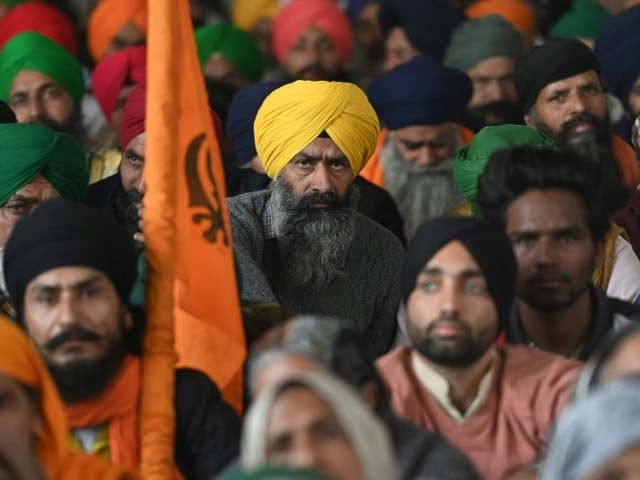Last week, a massive demonstration in India turned violent as hundreds of farmers clashed with police in the capital of New Delhi. The scuffle – which occurred after protesters occupied ramparts of the historic Red Fort – overshadowed the significance of Republic Day, a national holiday which marks the day the India’s post-colonial constitution came into effect 71 years ago.
This is the only instance of violence in a nearly six month long protest against three new agriculture laws passed by the Indian parliament in September 2020. The laws seek to deregulate the agricultural sector, but unions say they will hurt small farmers by incentivising large, private businesses.
These protests are significant because they expose tensions within the Indian economy where the agricultural sector’s contribution to the GDP has been declining for years despite employing around 41% of the workforce. At stake in efforts to repeal the new laws are the economic rights of poor farmers in India.
But the protests, in as much as they are a response to the private sector’s perceived encroachment in agriculture, also bring attention to a growing global trend toward industrial farming. In doing so, the actions of thousands of farmers can both dismantle the myth that large farms feed the world while also highlighting the unsustainable nature of our food systems.
First, it’s important to note the precarity small farmers in India live with daily. According to the 2016 national agricultural census, small and marginal-sized farms – defined as holdings less than two hectares – make up around 86% of Indian farms but cover only 47.3% of the cultivated land (which has been shrinking). A National Sample Survey Office report estimates that the average Indian farmer earned Rs 6,426 per month ($110) in 2013 with household expenses of Rs 6,223 ($107).
What little breathing room a small farmer has is protected by two Indian agricultural practices which have been around for decades. The first is the minimum support price (MSP), a guaranteed rate at which the government buys certain approved crops directly from farmers who are particularly susceptible to fluctuations in the agricultural market. Additionally, an Indian law from 2003 prohibits the sale of produce outside wholesale markets approved by individual state governments. Known as “mandis”, these markets, with their open auction sales, are meant to protect small farmers from being exploited by middlemen and large retailers.
The new laws propose to deregulate this system in three ways. The first law creates provisions for “contract farming”, whereby farmers can independently enter into agreements with businesses to sell their produce. The second law creates unregulated trade spaces outside mandis. In theory, farmers can now sell their goods to anyone, anywhere in the country. The final law amends a 1955 act under which several goods were deemed essential so that the government, in overseeing their production, supply, and distribution, could ensure they were available to consumers at fair prices. Under this third law, food items like oilseeds, potatoes, and onions are only considered essential in circumstances like war and famine, thus making them subject to market prices.
Critics claim these laws will erode the MSP and state-regulated mandis over time, even though proponents argue they don’t directly attack farmers’ protections. Some commentators see the decline in mandi business in 2020 after the laws temporarily went into effect as evidence of farmers’ preference to trade in an unregulated market because they escape fees and taxes.
But whether or not they help or harm farmers in the long term, an increase in contract farming and unregulated trade spaces, along with a lack of government oversight in food production, mean that large corporations and businesses have an incentive to move in. In protesting this possible reality, India’s farmers transcend a national debate about reforms to lay bare the potentially devastating impacts of private sector interests in agriculture.
In 2014, Grain, a non-profit organisation supporting small farmers, published a global agricultural report based on data collected from FOASTAT and various national authorities. It found that not only are small farms getting smaller, they are also being squeezed onto less than a quarter of the world’s cultivated land. Industrialised farming, itself an agrarian extension of private interests, meanwhile, is on the rise according to the report as is private sector investment in agricultural according to the Oakland Institute.
Those in favour of large-scale farming suggest economies of scale will make it possible to feed a growing global population. But this is unlikely for two reasons. First, despite having a tiny fraction of the land, small farms account for 70% of food production according to the UN. Second, even a cursory look at one of the largest, private food corporations in the world shows that companies like Cargill are not in the business of growing produce, despite investing heavily in farming around the world and owning around 50,000 hectares of land in South America. Instead, such giants grow materials like soybean and palm oil that are used as raw materials in both food and non-food related industries.
All of this can be summed up in one sentence: an increase in industrial farming means that the world is being fed by a shrinking proportion of cultivated land owned by farmers who own smaller and smaller portions of it.
Throw in the risks of climate change as well as unforeseeable events like the Covid-19 pandemic, and the protests in India – what is one of the world’s largest food producing countries – expose a difficult truth. That already insecure food systems around the world may be further threatened by private sector interests – at least when it comes to producing things people can eat.



COMMENTS
Comments are moderated and generally will be posted if they are on-topic and not abusive.
For more information, please see our Comments FAQ